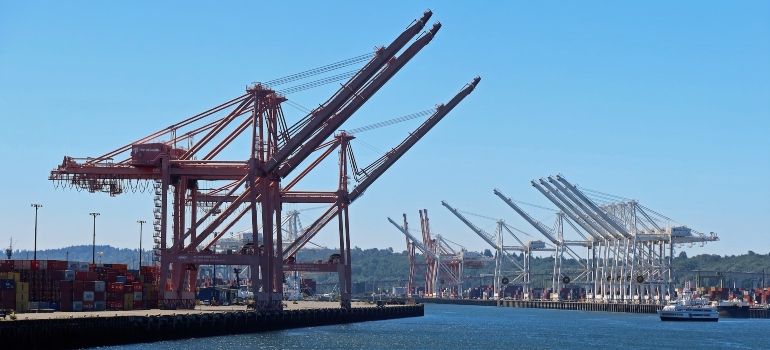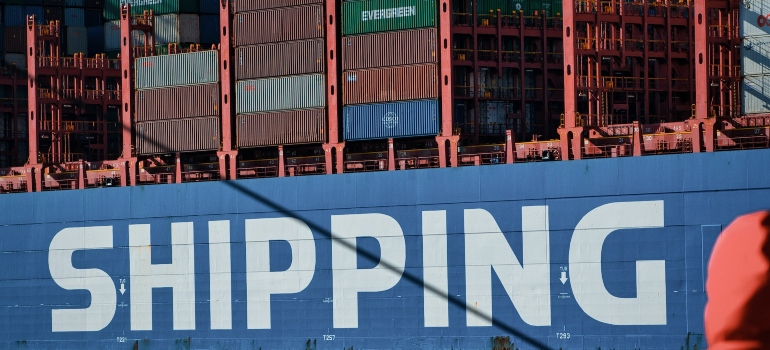What Does Shipping Large or Valuable Items Look Like?
When it comes to transporting items that are either oversized or hold significant value, the stakes are high, and the margin for error is slim. And besides, shipping large or valuable items involves a complex process that requires meticulous planning and execution. Therefore, our experienced team at Hansen Bros. Moving & Storage hopes to shed light on the various aspects of shipping such items, from understanding the inherent challenges to selecting the right shipping partner and preparing for the shipping process.
Understanding the Challenges of Shipping Large Items
Several factors influence the shipping process. Understanding these aspects is essential for anyone looking to ship large or valuable items, whether it’s a piece of fine art, industrial machinery, or a family heirloom:
- Size and weight of the item;
- Value of the item;
- Distance of transportation;
- Need for secure packaging;
- Handling requirements.
Each of these elements plays a crucial role in determining the approach and resources required for successful shipping. Hence, shipping large items presents unique challenges that require specialized attention. The sheer size and weight of these items make them difficult to handle, transport, and package.
Size and Weight Considerations
The size and weight of an item are primary factors in determining the shipping method and cost. Large items often exceed standard dimensions and weight limits, necessitating the use of specialized transportation methods. These items might require the services of freight companies in Seattle, which involves different logistics compared to standard parcel shipping.

The weight of the item not only affects the mode of transportation but also influences the cost. Heavier items are more expensive to ship due to the increased fuel and labor required. Additionally, oversized items may face restrictions in certain areas or require special permits for transportation, adding to the complexity of the shipping process.
Packaging for Protection
When shipping large items, the right packaging is crucial to protect them from damage during transit. This involves more than just wrapping the item in protective materials. It requires a comprehensive approach that includes:
- Assessing the item’s fragility,
- Determining the best packaging materials and
- Considering the potential risks during transportation.
Custom shipping crates Seattle providers offer are often necessary for oversized items, providing a tailored protective environment. This custom solution ensures that the item is securely held in place, reducing the risk of movement and consequential damage. The packaging must also be able to withstand various environmental factors, such as moisture, temperature changes, and impacts.
Logistics and Handling
The logistics of shipping large items are inherently complex. This complexity stems from the need for specialized handling equipment and vehicles, as well as the coordination required to ensure safe and efficient transport. Loading and unloading large items can be particularly challenging, often requiring cranes, forklifts, or other heavy machinery.
The route planning must also consider the item’s dimensions, as some roads or bridges may not accommodate oversized loads. Furthermore, the handling process must prioritize safety to prevent injuries and damage, both to the item and the infrastructure involved in its transportation.
Shipping Valuable Items: Safety and Security
Shipping items of high value, such as artwork, antiques, or luxury goods, involves a different set of challenges centered around safety and security. These items are not necessarily large, but their value makes them vulnerable to risks like theft, loss, or damage. That’s why we’ll explore the critical aspects of shipping personal and valuable items, including risk assessment, insurance and liability considerations, and the importance of secure packaging and tracking.
Risk Assessment
The first step in shipping valuable items is conducting a thorough risk assessment. This involves identifying potential risks and vulnerabilities that the item may face during transit. Factors such as the item’s fragility, value, and the route of transportation play a significant role in this assessment.

For instance, items that are highly fragile or have a high monetary value are at greater risk of damage or theft. Understanding these risks allows for the implementation of appropriate protective measures, such as choosing a shipping route with fewer risks or adding additional security measures.
Insurance and Liability
Insurance is a critical component of shipping valuable items. It provides financial protection against potential losses or damages that may occur during transit. When selecting insurance, it’s important to understand the coverage details, including what types of damage or loss are covered and the value of the coverage. Liability considerations also play a role, as the shipper needs to understand who is responsible for the item at each stage of the shipping process. In some cases, additional insurance may be necessary to fully cover the item’s value.
Secure Packaging and Tracking
Secure packaging is essential for valuable items. This is why reputable shippers are using high-quality, tamper-evident materials and techniques to protect the item from unauthorized access and damage. The packaging should be robust enough to withstand potential mishandling or environmental factors. Additionally, tracking the item during transit is crucial for security. Modern tracking technologies allow shippers and recipients to monitor the item’s location and status in real time, providing an added layer of security and peace of mind.
Choosing the Right Shipping Partner
Selecting the right shipping partner is a critical decision in the process of shipping large or valuable items. The chosen partner must have the expertise, resources, and reliability to handle your specific shipping needs. So, what are the criteria to consider when selecting a shipping partner, and which specialized shipping services cater to large or valuable items?
Criteria for Selection
When choosing a partner among shipping companies in Seattle, several criteria should be considered. Experience in shipping similar items is paramount, as it indicates the company’s ability to handle your specific requirements. The company’s reputation, based on customer reviews and industry recognition, can provide insights into its reliability and service quality. Besides, the range of services offered, including specialized services for large or valuable items, is an important consideration. Customer service and responsiveness are also crucial, as effective communication can significantly impact the shipping experience.
Specialized Shipping Services
Some items require specialized shipping services due to their size, value, or specific handling requirements. For example, climate-controlled transportation might be necessary for temperature-sensitive items, while white-glove services or HB move management ensure delicate handling and setup for fragile or high-value items. A shipping partner that offers these specialized services can provide tailored solutions that standard shipping companies may not be able to offer. These services often come with additional costs but offer the peace of mind and security necessary for shipping bulky or valuable items.
Cost Considerations in Shipping
Understanding and managing the costs associated with shipping large or valuable items is crucial for a successful shipping experience. Shipping costs can vary widely based on several factors, including the item’s characteristics, the shipping method, and additional services required. This section breaks down the components of shipping costs and offers strategies for cost-effective shipping.
Understanding Shipping Costs
A variety of factors influence shipping costs. The size and weight of the item directly affect the cost, as larger and heavier items require more resources to transport. Also the distance of the shipment also plays a role, with longer distances generally resulting in higher costs. The chosen shipping method, whether it’s ground, air, or sea, impacts the cost as well, with faster methods typically being more expensive.

Additional services, such as insurance, tracking, and specialized handling, can also add to the overall cost. Understanding these cost components is essential for budgeting and making informed decisions about the shipping process.
Cost-Effective Strategies
Several strategies can be employed to manage shipping costs effectively. Comparing quotes from different shipping companies can help in finding the most cost-effective option. Consolidating shipments, when possible, can reduce costs by shipping multiple items together. Choosing a slower shipping method can also be more economical, especially when time is not a critical factor. Planning ahead can help in avoiding rush charges and taking advantage of early booking discounts. Additionally, understanding and negotiating the terms of insurance and additional services can lead to cost savings.
Preparation Steps When Shipping Large or Valuable Items
Preparing for the shipping process is a crucial step in ensuring the safe and efficient transport of large or valuable items. This involves:
- The physical preparation of the item
- Handling the necessary documentation and
- Understanding customs requirements, especially for international shipments.
Hence, we’ll provide guidance on preparing the item for shipping and navigating the documentation and customs process.
Documentation and Customs
For international shipping, proper documentation is essential to ensure shipping large or valuable items goes smoothly. This includes customs forms, export and import documents, and any other required paperwork. Understanding the customs regulations of both the origin and destination countries is crucial to avoid delays and additional costs.
Duties and taxes may apply, and failing to comply with customs requirements can result in the item being held or returned. It’s important to work with one of the international commercial shipping companies with extensive experience, that can assist with the necessary documentation and customs procedures.
Preparing the Item for Shipping
Preparing the item for shipping involves several steps to ensure its safety during transit. The item should be cleaned and, if necessary, disassembled to reduce its size and make it easier to handle. Secure packaging is essential, using appropriate materials and techniques to protect the item. For large items, this might involve custom crating, while valuable items may require additional security measures.
Including detailed instructions for handling and unpacking can assist the handlers and reduce the risk of damage. It’s also important to label the package clearly with any necessary handling instructions, such as “Fragile” or “This Side Up.”

Navigating Delivery and Post-Shipping
The final stages of the shipping process involve navigating the delivery of the item and managing post-shipping considerations. Setting realistic expectations for delivery and understanding the steps to take after receiving the shipped item is important for a successful shipping experience. Here is what you need to know.
Delivery Expectations
Setting realistic expectations for the delivery of large or valuable items is important. Potential delays can occur due to various factors, such as weather conditions, customs clearance, or logistical challenges. Being prepared for these possibilities and maintaining communication with the shipping partner can help manage expectations and plan accordingly.
Post-Shipping Considerations
Once the item is delivered, it’s important to inspect it immediately for any signs of damage. If there are any issues, they should be reported to the shipping company promptly to address any claims or concerns. Keeping records of the shipping process, including documentation and communications, can be helpful for future reference or in case of disputes. Properly disposing of or recycling packaging materials is also a consideration, especially for large items that may come with substantial packaging.
Charting Your Shipping Course
From the initial considerations of size, weight, and value over choosing the right heavy equipment movers to the final steps of delivery and post-shipping, each aspect plays a vital role in ensuring the successful shipping of bulky or valuable items. It is a detailed and intricate process that requires careful planning, understanding of various factors, and choosing the right shipping partner.
Informing yourself about the challenges and solutions in shipping heavy, bulky, or valuable items helps you and your business navigate these complexities with confidence. To sum it up, with the right approach and resources, shipping large or valuable items can be managed efficiently, ensuring their safe and timely arrival at their destination.
Why Choose Us
History
Hansen Bros. Moving & Storage is locally owned and operated by the same family for four generations, since 1890. We have a well-established reputation for service quality and reliability with a high percentage of repeat household and commercial clients.
Professionalism
We’re a certified ProMover by the American Moving and Storage Association with A+ rating with the Better Business Bureau, voted “Best in Western Washington” in 2009 and from 2011 to 2016 by KING5. Our company is fully licensed and insured and member of WMC and AMSA.
Value
Hansen Bros. Moving & Storage provide free, no-obligation in-home estimate and competitive rates, including low minimum rates for shipments moving under 300 miles. We’ve set a refund policy for unused packing materials and three Puget Sound locations to help clients save on travel fee costs.



